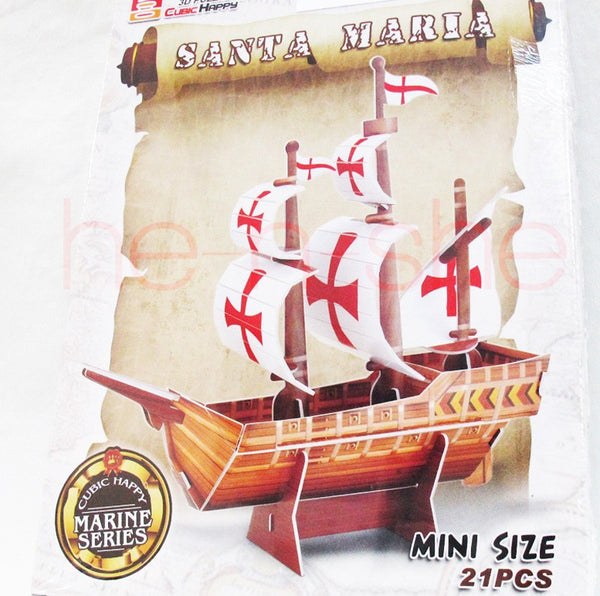2 Sets 3D Puzzle The Black Pearl Warship / Santa Maria used by Christopher Columbus
2 Sets 3D Puzzle The Black Pearl Warship / Santa Maria used by Christopher Columbus
Set 1: The Black Pearl Warship - Queen Anne's Revenge
Finished size: about 7" in Length
Queen Anne's Revenge was the name of English pirate Blackbeard's flagship, used by him for less than a year, but an effective tool in his prize taking.
In 1718, Blackbeard had gone aground in the ship at Beaufort Inlet, Carteret County, North Carolina, in the present-day United States. In late 1996, Intersal, the private contractor working for the state of North Carolina in marine recovery, discovered the remains of a vessel likely to be the Queen Anne's Revenge.
Set 2: Santa Maria used by Christopher Columbus
This is a very details Mini Size 21 PCS collectible 3D Puzzle - Vessel Santa Maria - Owned by Juan de la Cosa and used by Christopher Columbus in his first voyage.
Finished size: about 7" in length
La Santa María de la Inmaculada Concepción (Spanish for The Saint Mary of the Immaculate Conception), was the largest of the three ships used by Christopher Columbus in his first voyage. Her master and owner were Juan de la Cosa.
HISTORY
The Santa María was probably a medium-sized nao (carrack), about 60 feet long on deck, "very little larger than 100 toneladas" (100 tons), and was used as the flagship for the expedition. The other ships of the Columbus expedition were the smaller caravel-type ships Santa Clara, remembered as La Niña ("The Girl"), and La Pinta ("The Painted One"). All these ships were second-hand (if not third or more) and were never meant for exploration. The Niña, Pinta, and the Santa María were modest-sized merchant vessels comparable in size to a modern yacht, and not the largest ships in Europe at the time.
The Santa María was originally named La Gallega ("The Galician"), because she was built in Pontevedra, Galicia, in Spain's north-west. It seems the ship was known to her sailors as Marigalante, Spanish for "Gallant Maria". The naos employed on Columbus's second voyage was named Marigalante and Gallega. Bartolomé de Las Casas never used La Gallega, Marigalante or Santa María in his writings, preferring to use la Capitana or La Nao.
The Santa María had a single deck and three masts. She was the slowest of Columbus's vessels but performed well in the Atlantic crossing. She ran aground off the present-day site of Cap-Haïtien, Haiti on December 25, 1492, and was lost. Realizing that the ship was beyond repair, Columbus ordered his men to strip the timbers from the ship. The timbers from the ship were later used to build Môle Saint-Nicolas, which was originally called La Navidad (Christmas) because the wreck occurred on Christmas Day.
The anchor of the Santa María now resides in the Musée du Panthéon National Haitien (MUPANAH), in Port-au-Prince, Haiti.
















